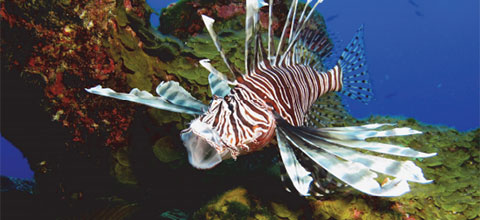Authors:
Michelle A. Johnston, Stephen R. Gittings, and James A. Morris, Jr.

The explosion of the Indo-Pacific lionfish (Pterois volitans and Pterois miles) is a serious threat to Atlantic, Gulf of Mexico, and Caribbean coral reefs, with potential long-term consequences affecting native fish communities and habitats. Lionfish are well-known for their venomous spines, rapid colonization rate, and generalist preferences for both habitat and diet. Invasive lionfish are capable of causing significant impacts to biodiversity and recovery of coral reefs, a result of their high densities and predation rates on native fish communities.
The National Marine Sanctuary Act resource protection mandate aims to "maintain the natural biological communities in the national marine sanctuaries, and to protect, and, where appropriate, restore and enhance natural habitats, populations, and ecological processes." As it relates to the lionfish invasion, the goal of NOAA's National Marine Sanctuaries Lionfish Response Plan is to minimize ecosystem degradation in affected sanctuaries so that benthic habitat does not degrade and sanctuaries continue to serve as refuges for native reef fish species. Lessons learned from the lionfish invasion will make managers better capable of dealing with future invasions by other species, should they occur.
This plan aims to identify critical actions needed to minimize the impact of this unprecedented marine invasion. Four national marine sanctuaries have been invaded by lionfish – Gray's Reef, Florida Keys, Flower Garden Banks, and Monitor. The plan recommends science, service, and stewardship activities for the first three sanctuary sites, as activities at the Monitor are much more limited and will only be discussed briefly. Prior actions by the sanctuaries to deal with lionfish, as well as future activities, rely on collaborations among agency programs and offices, as well as partners outside NOAA, including international collaborations around the wider Caribbean.
This response plan summarizes information on the scope and status of the lionfish invasion, the threats posed to national marine sanctuaries, and the challenges to managing the invasion. It also summaries current activities taking place, as well as calls for actions to be planned, coordinated, and supported nationally or regionally and actions specific to the individual marine sanctuaries within the invaded range. All actions are directed at management measures that will minimize impacts caused by the invasion, specifically in the areas of monitoring, control, research, and education and outreach. These actions are consistent with those called for in the National Ocean Policy Implementation Plan and other local, regional and national plans specific to the lionfish invasion.
Key Words:
Invasive species, lionfish, Gray's Reef National Marine Sanctuary, Florida Keys National Marine Sanctuary, Flower Garden Banks National Marine Sanctuary, NOAA

